Let’s learn the differences between W365 Cloud PC and AVD Cloud VDI. Microsoft offers 3 main ways for users to access Windows: the traditional PC experience, Cloud VDI with Azure Virtual Desktop (AVD), and Cloud PC through Windows 365.
The first method is the one you are already familiar with. Now, let’s delve into the other 2 options to understand their unique features and benefits.
Azure Virtual Desktop has become a cost-effective Cloud VDI solution, especially for organizations familiar with in-house VDI. On the other hand, Windows 365 is a Software as a Service (SaaS) solution.
The new Azure Virtual Desktop app is now available in the Microsoft Store, Winget, and Microsoft Intune. Windows 365 is an innovative cloud-based service that simplifies the creation of Windows virtual machines known as Cloud PCs. With Windows 365, users can efficiently manage the Power On and Power Off functions of their Cloud PCs.
- New Features Windows 365 Cloud PC 2311 November Service Release
- Windows 365 AI based Cloud PC Resize Recommendations
- How to Connect AVD Remote Desktop Resources Client or Browser?
- How to Deploy Remote Desktop Client using ConfigMgr | SCCM | WVD
What are the Different Ways Microsoft Delivers Windows to Users?
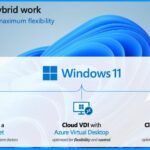
There are 3 main ways that Microsoft delivers Windows to users. The traditional PC experience, which most users are familiar with, Cloud VDI with Azure Virtual Desktop (AVD), and Cloud PC through Windows 365.
Differences between W365 Cloud PC and AVD Cloud VDI
Azure Virtual Desktop is a Cost-effective Cloud VDI solution, especially for organizations with in-house VDI experience. Windows 365 is a Software as a Service (SaaS) solution providing Cloud security with a familiar physical PC experience.
| Microsoft offers 3 main ways for users to access Windows |
|---|
| Native on a PC or Tablet |
| Cloud VDI with Azure Virtual Desktop |
| Cloud PC on any device with Windows 365 |
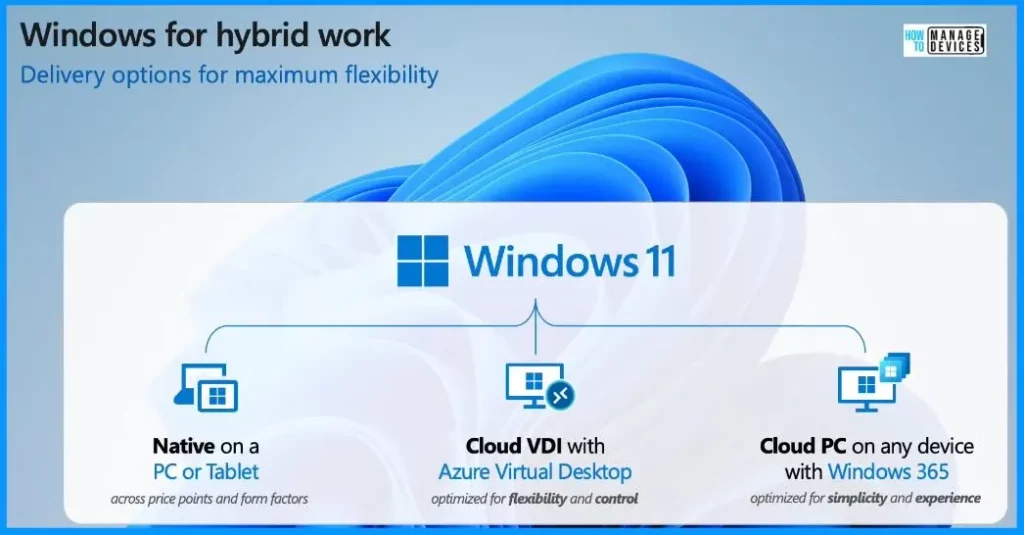
Azure Virtual Desktop is a powerful way to support new hybrid work strategies. It offers secure remote desktops with maximum flexibility and control. The key advantage is reducing costs through Windows 11 and Windows 10 multi-session. It allows multiple users on a single virtual machine.
On the other hand, Windows 365, positioned on the far right, is a Software as a Service (SaaS) solution. It combines Cloud security with the familiar experience of a physical PC. Employees can stream a Windows desktop from the cloud to any device without VDI expertise. Windows 365 simplifies the VDI experience, making it more accessible to a broader audience.
| Azure Virtual Desktop | Windows 365 |
|---|---|
| Shift on-prem VDI to the Cloud | Secure work on personal PCs |
| Leverage existing VDI investment and expertise | Onboard and offboard employees |
| Enable remote app streaming and non-persistent desktops | > Simple to buy, deploy, and manage > No employee or IT special skills or training > Quickly scale and resize |

Microsoft Cloud Solution Options
Let’s discuss the Microsoft Cloud solution options. A Cloud VDI platform that delivers hosted desktops and apps with maximum flexibility and control. Windows 365 is a complete SaaS solution that securely streams your personalized Windows desktop, apps, settings and content from the Microsoft Cloud to any device.
| Details | Azure Virtual Desktop Cloud VDI | Windows 365 Cloud PC |
|---|---|---|
| OS support | Windows 11, Windows 10, single or multiple session, Windows server | Windows 11 or Windows 10 |
| Admin | > Aure portal > VMware or Citrix management plane | > Microsoft Intune (Enterprise) > Web self-service ( Business) |
| Service | PaaS – Granular controls over configuration and management | SaaS – Complete end-to-end Microsoft service |
| Pricing | Consumption-based | Per-user, Per-month |
| Scale | Unlimited based on consumption | Unlimited based on subscription |
| End-user | Single or multi-user, pooled, remote app | Full Windows-like local experience |
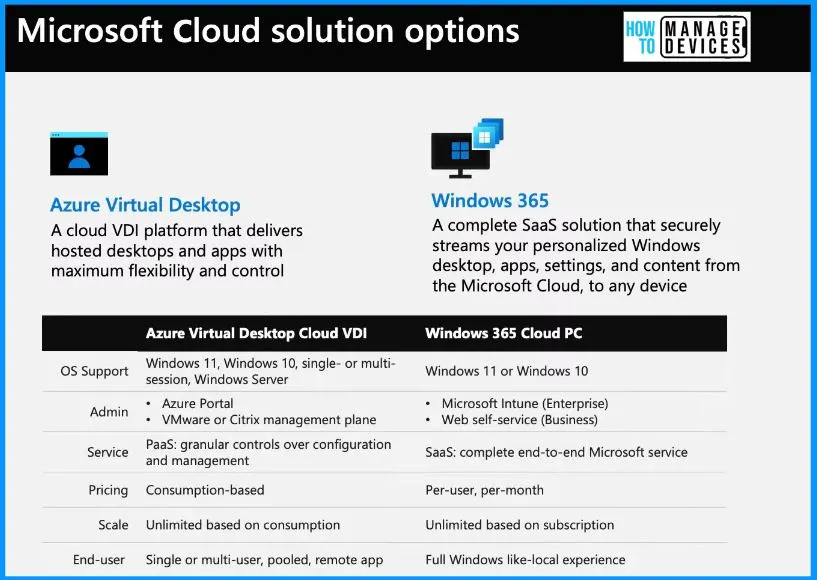
Thoughts and Considerations
Intune can manage AVD – Consider Entra joining Pooled and Personal Desktop hosts. Leverage Intune instead of GPO to deliver policies and configurations. (Both FSLogix and AVD ADMX are available in Intune).
For AVD, realize you will need to upskill & learn how to perform IT in Azure and create VNET, S25 VPN, and Azure storage. Azure will seem daunting initially; start small. Engage your organization’s desktop admins (aka the Intune and ConfigMgr ad); they will know Entra ID and device management. Engage and leverage your FastTrack benefit for onboarding assistance.
- W365 is simple and super easy; even a desktop admin can do it, But AVD is pretty easy.
- AVD will require more excellent knowledge of Azure.
- W365 does not require Azure subscription (when using Entra Joined and Hosted network)
- Fine-tune your AVD scaling plans to balance host availability and cost management since AVD is a metered service.
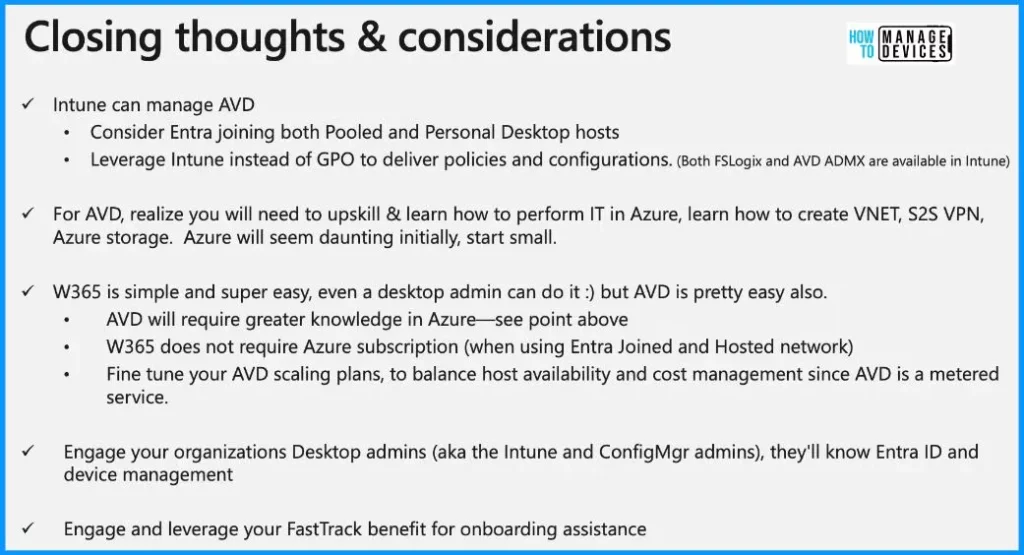
Comparison between the On-premises VDI Cloud VDI and Cloud PC
Let’s discuss the on-premises VDI, cloud VDI, and cloud PC. The table below helps you show the differences between the on-premises VDI, cloud VDI, and cloud PC.
On-premises VDI involves ownership, upfront costs, and expertise requirements. Cloud VDI combines cloud advantages with scalability and shared responsibility. Cloud PC, as a SaaS solution, prioritizes user simplicity and predictable costs with minimal expertise needed.
The choice among these options depends on factors like cost considerations, scalability needs, and the level of expertise available within the organization.
| Details | On-premises VDI | Cloud VDI | Cloud PC |
|---|---|---|---|
| Technology | RDS / Citrix / VMware | Azure Virtual Desktop, Citrix DaaS, VMware Horizon Cloud | Windows 365 |
| Infrastructure | Physical Datacenter | Cloud | Cloud |
| Service | Customer-owned and operated | laaS + PaaS: Granular controls over configuration and management | SaaS: complete end-to-end Microsoft service |
| Pricing | High upfront hardware costs, annual license renewals | Consumption/usage-based | Predictable per user, per month |
| Scale | Limited based on hardware and expertise | Unlimited based on consumption / usage | Unlimited based on licenses |
| Expertise Required | VDI & Infrastructure expertise | Leverage existing VDI investment and expertise | No VDI and infrastructure expertise |
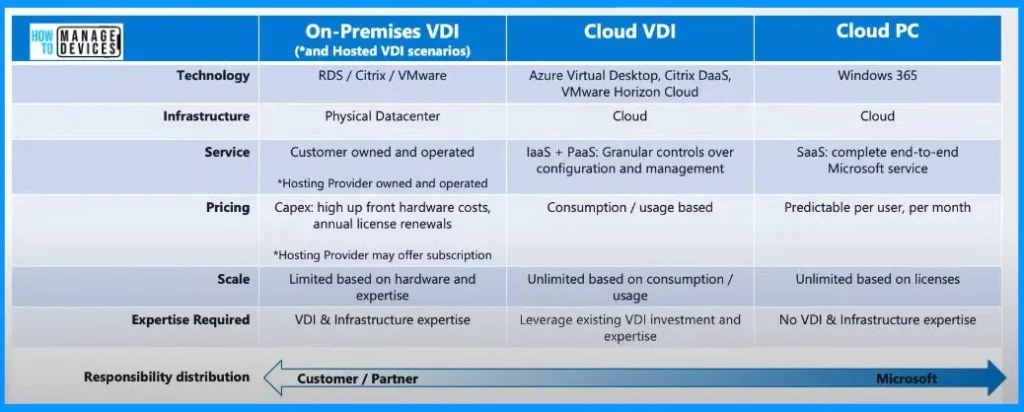
Accelerate your migration to Windows 365 and Azure Virtual Desktop (youtube.com) – NOTE! – Microsoft shared detailed information on Differences between W365 Cloud PC and AVD Cloud VDI with the latest Technical Takeoff session by Eric Orman.
We are on WhatsApp. To get the latest step-by-step guides and news updates, Join our Channel. Click here – HTMD WhatsApp.
Author
About the Author – Vidya is a computer enthusiast. She is here to share quick tips and tricks with Windows 11 or Windows 10 users. She loves writing on Windows 11 and related technologies. She is also keen to find solutions and write about day-to-day tech problems.
